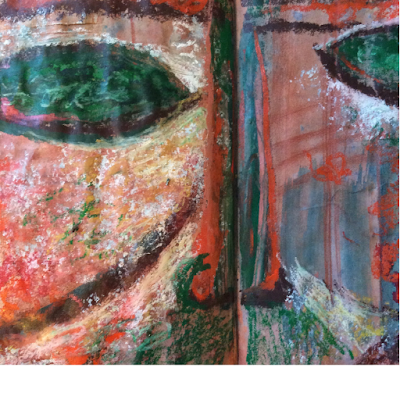Module Five – Chapter TEN – STITCH TO TRANSLATE
For Chapter TEN some rubbings from the previous Chapter are to be translated into stitch, using mainly only one stitch for each sample but in different forms, shapes and sizes. For all samples my background is the same black wool fabric, a remnant from a skirt I made a long time ago, and white or off-white threads as in all this Module.
I find that for most rubbings other stitches could have been used for translating marks and for me it was rather difficult to decide which one was best for the task at hand!


- This is my first rubbing of choice, taken from the paper relief on the right. I see in it three main vertical lines around which I planned my stitching.
- I used only buttonhole stitch on this sample, going vertically and then crossways. Two whitish threads are used, a basic No. 50 machine thread and a mohair yarn. The shaded areas are made from very loose fleece held down by stitch. I added silvery bugle beads in some focus areas.




The rubbing on the left was taken from the tracing paper sample on the right moving it to different angles.
The fabric was first rubbed with a white crayon on the same paper sample to get a ghost image.
I used Cretan stitch both in rows and isolated. In some areas I stitched on the back side so as to get single “dashes” on the front mainly for couching fibres and tulle net bits.

 The paper sample below was rather flat but had interesting triangular shapes which left distinctive marks when rubbed and I thought that these hard shapes could be hinted at by asymmetric cross stitches.
The paper sample below was rather flat but had interesting triangular shapes which left distinctive marks when rubbed and I thought that these hard shapes could be hinted at by asymmetric cross stitches.The background fabric was first stamped with a triangular sponge using a white gouache and the resulting patches were partially covered in stitch and underlined by huge wrapped cross stitches.


This rubbing was rather a surprise! The white crayon was dragged on the side leaving muted smudges.
For this sample I chose a very simple darning stitch. The foundation is machine darning with the addition of hand darning, very loose in some areas, and heavily distressed lace bits.







These are beautiful samples Daniela
ReplyDeleteGreat stuff Daniela. The first is my favourite.
ReplyDeleteAs usual your samples are wonderful, so much life and interesting details, I love the big pics 3 and 4, you'r very talented.
ReplyDelete